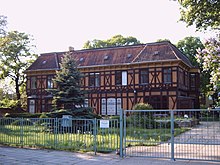Richard Toepffer
Karl Richard Toepffer (born May 27, 1840 in Stettin , † June 19, 1919 in Magdeburg ) was a German industrialist. He was instrumental in the introduction of the steam plow and steam threshing in Germany .
Life
Richard Toepffer was the son of the Kommerzienrat Gustav Adolf Toepffer , co-owner of one of the largest German cement factories, which his brother Albert Eduard Toepffer took over in 1883 . He first attended a grammar school in Szczecin and then began to be interested in agriculture . During the World Exhibition in London in 1862 , Toepffer, who was interested in modern mechanical agricultural technology, met the inventor of the steam plow, John Fowler .
Toepffer initially stayed in England to take a job at Fowler's company John Fowler & Co. , where Max Eyth was also employed. In February 1864 he went to Egypt for the company to manage the operation of 100 steam plows as chief engineer on behalf of the Egyptian viceroy Ismail Pasha . After a few years Toepffer came back to England and founded a steam plow company . Steam plowing, which had previously been unaffordable for most, became economically viable for broader circles through this society. From 1868 he tried to introduce the steam plow in Germany. A first plow was set up in an estate near Wolmirstedt in 1868 . Corresponding demonstrations were also held in Mahndorf , Adersleben , Ermsleben and Hoym .
The opening of a Fowler branch in Magdeburg , which had already been initiated , was stopped by the Franco-German War . The patriotic Toepffer immediately volunteered for military service. During the war, Toepffer managed to use two steam road locomotives ( locomotives ) from the Fowler company for military purposes based on his proposal . Mainly ammunition and heavy equipment were transported in the front area. The mission was rated as a success. Toepffer received several medals.
Toepffer opened a branch of the Fowler company for contract steam plows in Magdeburg, of which he later became a partner. In addition to steam plows, steam rollers and street locomotives also came into the company's range.

In 1895 Toepffer acquired the "Aevermannschen Hof" , a Heidehof in need of renovation , in Lopau . The old farmhouse had to be demolished because it was in disrepair. He converted a barn into his home and turned the 3,000- acre area into a representative country estate. The property was also used to demonstrate new agricultural and forestry machinery. In particular, he wanted to demonstrate the efficiency of steam plows on the impoverished soils in preparation for reforestation and arable farming. The heath poet Hermann Löns mentions these activities in his book Haidbilder , chapter Das Könekenmeer .
" If you walk along Hützeler Weg from Lopau, which is back there in the Haide between Ülzen and Munster [...] Before the steam plow rummaged through the land here and prepared the ground for the loads [pines] [ ...] everything was bare Schnuckenheide [...] "
The traces of deep plowing can still be seen today. In 1922 the estate was sold to the state. Today it belongs to the Munster -Nord military training area , on the extreme northern edge of this area. The Töpfers estate itself was demolished in 1978 by the Bundeswehr. The " Haus Schilling ", named after a displaced person who lived here after the Second World War , was the home of the overseer family in Potter's time, is now a home for the Munster Forest Youth . The former home of the forest workers (Alte Forstwartei ) now serves as the operating and residential building of the Federal Forests division of the Federal Agency for Real Estate . The pottery tower on the right bank of the Lopau Heath River is reminiscent of Toepffer .
Toepffer bought a 15 acre property in Magdeburg as early as the 1880s. A residential building, the Villa Toepffer , and the associated Toepffers Park , laid out in 1884, were built here from 1885 to 1891 . While the house still exists today, the park was later built over. The street name Toepfferspark still reminds of him .
Toepffer's grave is in Magdeburg's Westfriedhof .
See also
literature
- Manfred Beckert: Toepffer, Richard. In: Guido Heinrich, Gunter Schandera (ed.): Magdeburg Biographical Lexicon 19th and 20th centuries. Biographical lexicon for the state capital Magdeburg and the districts of Bördekreis, Jerichower Land, Ohrekreis and Schönebeck. Scriptum, Magdeburg 2002, ISBN 3-933046-49-1 .
- Martin Wiehle : Magdeburg personalities. Published by the Magistrate of the City of Magdeburg, Department of Culture. imPuls Verlag, Magdeburg 1993, ISBN 3-910146-06-6 .
Web links
| personal data | |
|---|---|
| SURNAME | Toepffer, Richard |
| ALTERNATIVE NAMES | Toepffer, Karl Richard (full name) |
| BRIEF DESCRIPTION | German industrialist |
| DATE OF BIRTH | May 27, 1840 |
| PLACE OF BIRTH | Szczecin |
| DATE OF DEATH | June 19, 1919 |
| Place of death | Magdeburg |



